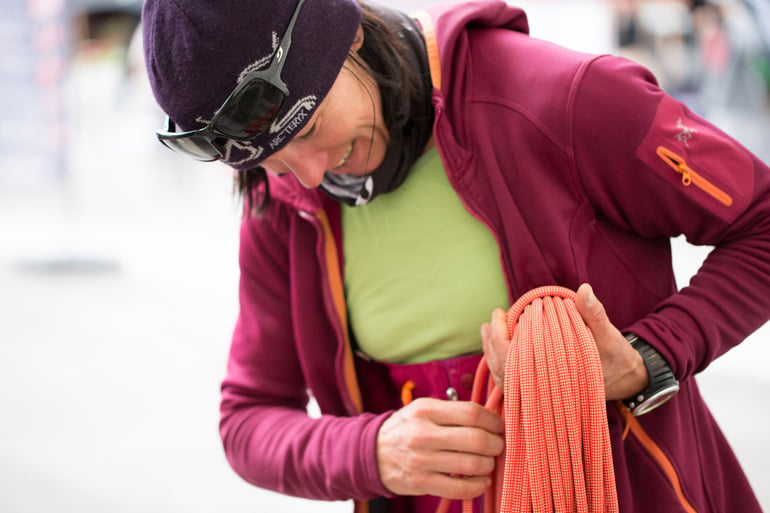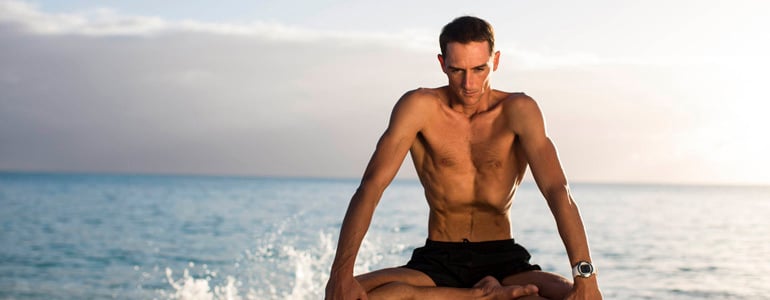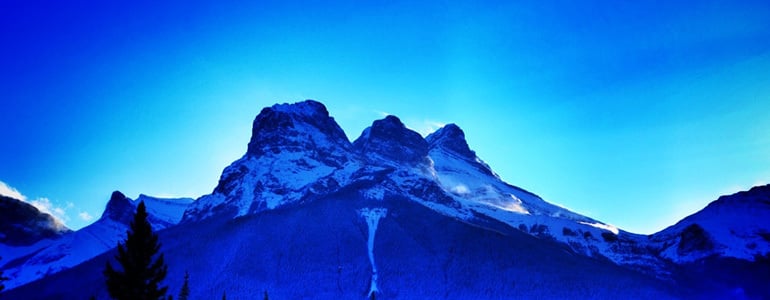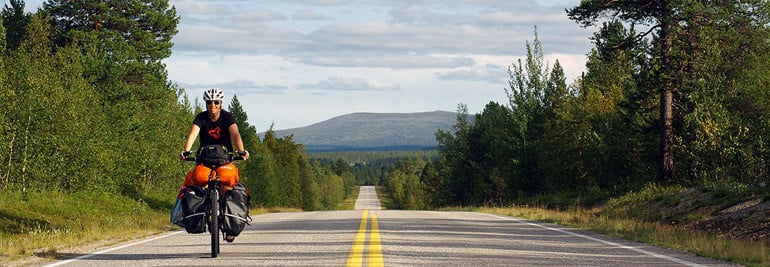

Suunto Blog

Get more from your Ambit GPS watch.
Mountain guide Fabien Meyer offers some tips on how you can use the altimeter function to better understand the weather and how to use the compass to navigate. Don't become fixated by knowing your exact altitude and re-calibrating every ten minutes. “Don't be obsessed about it,” says Meyer. “It's more important to understand what's going on with the pressure.”“If you get an altimetric increase of altitude while you're at the same height, the atmospheric pressure is going down,” he says. “A big advantage is the new Fused Alti technology: it calibrates your altimeter with GPS, so you can follow the evolution of the pressure even as you move vertically, so long as the sky is clear,” he adds.
Click here to find out how the Track back feature can help you navigate safely
Understand how pressure works: “When you're at sea level a difference of 1hPa is equal to approximately 7m. At the summit of Everest it's about 10m. For example, say you calibrate at 2,000m and climb to a 4,000m peak but your Ambit says 4,200 m, you know there's been a drop of approx 20hPa. That's a big drop and you should turn around. Especially if you notice humidity in the air.”Use the compass“It's very important to have a compass especially when you still do not need it ;-).” says Meyer. “The Ambit compass is very accurate and you won't leave it at home because it is on your wrist. It's very quick to orientate yourself and gain the right direction. Check often “There are lots of different configurations, in all of them, I try to minimize my dependence on electronic gear. For me the safest when it is serious (no visibility and dangerous terrain) is to check my position every 1 to 30 minutes (depending how dangerous the terrain is) and to fix a bearing that I follow during each stage. “Even if your watch bearing is accurate and safe you don't need 100% accuracy with bearings. In bad weather, if you're glued to a screen you may end up in a crevasse! It's better to check your position often and do lots of little bearings rather than follow a straight line – you're not a sailor.” Use the bearing lockUsing this, you can take a bearing to the next waypoint and off you follow. The track back is also a very useful feature and when it is turning bad it gives you a solution in any circumstances, serious or not, but don’t forget it doesn't work on steep terrain.Want to go ice-climbing with Fabien Meyer? He will be one of several guides at the Cogne Ice Opening in December. Click here for more details.

Infographic: What happens when you go deep?
What happens to the body when you go deep? This infographic explains some of the physiological changes that the body goes through on a dive. But one thing it can't explain – and that's the feeling.
Says Will Trubridge: “I love freediving because it's an opportunity to escape from gravity, sound, light (if you go deep) and even the sensation of time passing. A deep freedive can be like a dream, in that all the rules of reality seem changed.”
Dive in below to discover more about the sport, the physiology and the different disciplines...
infographic created by: zooom.at/Adi Sumic
The Dive Reflex
It is often said that humans are perfectly adapted for diving underwater thanks to the 'mammalian or dive reflex' – something we share with other aquatic mammals such as whales and dolphins. The main feature of this is the way the heart rate automatically slows once the face is submerged in water to reduce oxygen consumption. The dive reflex kicks in again after approximately 25 m: the heart rate slows by as much as 50% and vasoconstriction takes place. This is where warm blood retreats from the body's extremities to protect core organs.
At this depth most divers can stop swimming. “Here I have lost enough buoyancy from lung shrinkage under pressure that I can stop swimming and freefall for the rest of the descent,” says Will.
Freediving Disciplines:
There are three main depth disciplines in competition freediving: Constant Weight No Fins (CNF): The freediver descends and ascends without any assistance (only using arms and legs without fins).Constant Weight with Fins (CWT): The freediver descends and ascends using fins/monofin and the use of arms.Free Immersion (FIM): The freediver dives without the use of fins/monofin, but pulls a rope during descent and ascent.Says Trubridge: “CNF and CWT are the two most popular disciplines. CWT gives the deepest performances, while CNF is seen as the purest expression of human aquatic potential. FIM is more of a relaxed discipline, but there are definitely some very serious practitioners there as well!”

TRACKING BACK WITH AN AMBIT
Last August Estonian ski mountaineer Argo Mere attempted to ski down 7,546 m high Muztagh Ata on the northern edge of the Tibetan Plateau in China. Unfortunately the weather conditions didn't make reaching the summit easy: Mere and his group had already spent two nights at camp 3 at 6,800 m but the weather stayed poor.
“We were waiting for an opening to continue to the top, but zero visibility and continuous snowfall blocked the way up,” he says.
Finally the team decided to turn back.
“On the human side, nothing was left undone but nature wasn’t in our favor this time,” he says.
Descending in a total white-out wasn’t easy either.
“Since I was the only one on skis I had problems waiting for the others. Looking at the track now I can see that somehow I turned too much right.”
Once Mere realized he was off track – and too close to the big cliffs (dark on the map on skier's right) – he decided to escape back up the same way he had skied down.
“I put my skins back on, turned my Suunto to Trackback and managed to return to the right track and also found my friends.”
Mere says they found their previous camp thanks to his Ambit’s Track back function.
“Yes, it was quite adventurous and nice that a 'gadget' turned to something vital in returning,” he adds.
HOW TO TRACK BACK WITH AN AMBIT
In the story above Argo Mere used the Ambit’s Track back function. With Track back, you can retrace your route at any point during an exercise.
To track back during exercise:
While you are in a sport mode, keep [Next] pressed to access the options menu.
Press [Next] to select NAVIGATION.
Scroll to Track back with [Start Stop] and select with [Next].
You can now start navigating your way back the same way as during route navigation.
During navigation, press [View] to scroll the following views:
The full track view showing the whole route
Zoomed-in view of the route. (By default, the zoomed-in view is scaled to a 200 m/0.125 mi scale, or larger if you are far away from the route. You can change the map orientation in the watch settings under GENERAL / Map.)
Waypoint navigation view
You can read more about navigation in your watch’s user guide. The user guide for your product can easily be found in register after you have registered your product in the same location.
NOTE: If the GPS accuracy setting of your sport mode is Good or lower, while navigating GPS accuracy switches to Best. Battery consumption is therefore higher.
You can get support for your Suunto product at support
Main image ©John Hill / Flickr

Winter is coming: is your body prepared?
Matthias Scherer and Tanja Schmitt are two of the most active ice climbers in the world. How are they preparing their bodies for the upcoming season? By dry-tooling and cranking out sets of pull-ups and other drills in the gym, that's how. Below, they share some of their training secrets.
Dry-tooling “Drytooling means climbing with ice tools and crampons on rock,” says Matthias. “It's a very good physical preparation for ice climbing but should not be confused with ice climbing. Ice climbing is (like alpinism) all about the experience. You have to be willing to learn new things continuously and constantlyadapt to the challenge the ice or the mountain presents. Matthias Scherer drytooling in Canmore, Canada. ©Tanja Schmitt
Many of the drytooling crags feature drilled holds. Drilled holds gives you the advantage that your tools will "stick" safely in the rock, so you can do athletic moves without the chance of popping your tool off – but you will not learn the skills how to scratch and place tools precisely on natural features. Those skills are primal when it comes to real mixed climbing. So new school drytooling on drilled holds is a great way to get physically fit, but it will not replace, or give any experience for ice or mixed climbing.”
Tanja Schmitt drytooling in Canmore, Canada. ©Matthias Scherer
“Our goal was to build core and arm strength Since we were able to climb a very athletic M9 10 times in one hour means that we achieved our goal!
Indoors – at the gymWhile the best form of training is the real thing, gym sessions are also important parts of any fitness regime. These are some of the drills that Matthias and Tanja perform. “Our training in the weight room has the unique goal to compensate the hard impact that drytoolinghas on the body. So we train the opposite muscles after each Drytool workout next day in the gym. The training does not take a long time, in fact it can be done in 40-60 minutes. 20 minutes of a warm-up is however essential! Basically we do three circuits consisting of 6 different exercises. Each exercise or “set” consists of 10-15 repetitions and two minutes rest beween exercises.”
Matthias front lifting weights. ©Tanja SchmittOne circuit consists of:
Lateral Raises with adjustable dumbbells
Front lifting with adjustable dumbbells
Reverse butterly
Chin pulls with a barbell
Push ups
Hanging leg raise (straight and bent arm)
Tanja performing lateral raises. ©Matthias Scherer
A quick daily training routine during the whole year when the pair can not go climbing is:
3 x 30 pull ups - two sets on tools, one on hands3 x 30 push ups3 x 15 hanging leg raises3-5min rests between exercises. “In fact, we go on the slackline in between the sets, it's less boring.”

Couple depart on ultimate Nomad trip
Janick Lemieux and Pierre Bouchard are on the first leg of an epic cycle journey NOMADS² from northern Europe to the southern tip of South Africa in search of indigenous nomadic peoples. Janick Lemieux and Pierre Bouchard are no strangers to long cycle journeys. The Canadian couple previously spent six years on a 60,000 km 'cyclovolcanic' quest around the Pacific. For this trip, their plan is to cycle 35,000 km from Nordkapp Norway to Cape Agulhas, South Africa via 50 countries and dozens of nomadic groups. “We're embarking on an epic ride and a true voyage of exploration!”So far they've already cycled across Norway and encountered the Sami reindeer herders. “We snaked our way up north amidst its jaw-dropping fjords and celestial plateaus jutted with glaciated peaks and entered Sami (Lapland), traditional territory of the first nomads on our list, and were riding on the lookout for reindeer, their summer pastures and their herders,” the pair say in their latest dispatch.
Besides Norway, they've also cycled across Finland's wilderness. “It's a land of magnificent taiga forests speckled with a multitude of lakes, vital marshes, and vast expanses of tundra covering summits and upper reaches of tunturis or fells. Reaching some 800 m above sea level, the venerable bald ridges are the sole survivors of billion of years old lofty mountain ranges. With their abundant lichens and few mosquitoes, they provide ideal summer grounds for reindeer. It's been a real immersion in this amazing land,” they add. It's not just remote indigenous peoples whom the pair have met. They also managed time for an encounter with an equally engaging team of individuals – the workforce at Suunto's HQ in Vantaa, Finland. We wished them the best of luck in their onward journey.
Images: © Pierre Bouchard

Suunto introduces new colors for D4i
The all-round dive computer comes out in two new editions
The Suunto D4i is now available in two new colors to guide divers on their underwater adventures.
With four dive modes – including freediving – Suunto RGBM algorithm, and the option of wireless integration, the Suunto D4i is the dive computer of choice for all divers looking for a lightweight, reliable and stylish dive computer.
With the pink edition, it gets a splash of color. It's the perfect fit, whether blending in with a coral reef or your style out of the water. The gray Suunto D4i makes for a modern and streetwise alternative to black.
The Suunto D4i is already available in black, white, blue and lime. It features a soft silicone strap, ensuring maximum comfort as well as a superb fit and is designed to suit the needs of all divers – for every diving occasion.
The Suunto D4i Novo Pink and Gray will become available in January.










































































